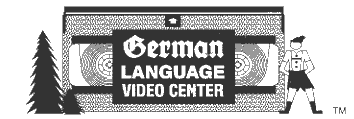
 |
The place where our customers send their friends!
Welcome to the Only
American Video Tape Store for rare German Movies and Old ZDF volksmusik shows.
Please note:
All video tapes are in the American NTSC VHS video
format
and will play on all VCR's in North America. We are closing out all of our
VHS inventory. This will be your last chance to obtain these beautiful ZDF
music videos and hundreds of classic German movies and heimatfilme. Due to
the limited demand in the USA, most of these movies will unfortunately never
be available on DVD in America.
Once our videos are gone, they're gone!!!
We have drastically reduced the prices on over 2000 video titles closeout.
Make sure to buy these classics while supply lasts.
On all VHS clouseout prices we will
send you a new or previously viewed tape.
CLOSEOUT!!!!!
BUY NOW!!!
Any 10 videos for
only $49.95
plus
$19 s/h
while supplies last
WAR DOCUMENTARIES VIDEO TAPES
Suggested for scholarly and educational use.
B
Berlin Blockade and Airlift
FA 237
(1968), English dialogue, b/w, 20 min. - On August 25, 1940, the Royal Air Force
made its first raid, beginning a five-year siege that would end only after 80,000
civilians had been killed. This footage, suppressed until now as too harrowing
to show, brings to searing light the devastating tragedy and miracle of Berlin.
Ein Tag im Juli: Berlin 1945CH
617
Germany, 1972, Color, 50 minutes, German commentary - US Air Force cameramen
captured these Berlin scenes on color film in July of 1945. They include conversations
with Berliners, Truman being greeted by Gromyko (who was then serving as an
expert on Germany) while Truman was enroute to the Potsdam Conference, refugees,
views of places that were famous before the War, wood auctions in the Tiergarten,
and rubble being cleared by Truemmerfrauen.
*No Longer Available*
The Baltic Tragedy
Germany/USA/USSR, 1940-1946, B&W, Total running Time: 148 minutes, sound
with English Subtitles. - Hitler's war on Russia is graphically portrayed in
11 original German wartime newsreels. The northern sector of the Germans' eastern
front, where ferocious battles were fought in Latvia, Lithuania, Estonia and
Finland, is featured. Four additional international documentaries--including
one produced by the Soviets in 1944--present a well-rounded picture of the tragic
plight of the Baltic peoples during World War II. Here is the story of the "captive
nations"--whose lands became a killing ground for one of history's most
brutal wars.
Special care has been taken by International Historic Films to assemble this
monumental documentary, which tells the story of what is left for a people after
its land has been ravaged by war. Situated between the powerful antagonists
Germany and the Soviet Union, the Baltic nations of Latvia, Lithuania, and Estonia
bore witness to some of the most ferocious land battles of the Second World
War.
Every film and film sequence included in this unique compilation is the result
of years of painstaking research by International Historic Films. The American,
German, Latvian, and Soviet films which compose the program have all been selected
both for their historical contributions to the theme of The Baltic Tragedy and
for the exceptionally high visual quality of the original negatives from which
most of these sequences were reproduced. The segments are chronologically arranged,
and introduced with brief explanatory titles.
I. My Latvia
A documentary featurette of the illegal Soviet military occupation of the three
then-autonomous Baltic states in 1940. This unusual film, which illuminates
communist methods of internal subversion and conquest, includes rare scenes
of Stalin and other Soviet leaders attending closed Kremlin meetings, and examines
the criminal background of the Latvian nationals who "invited" the
Soviets into that country and subsequently assumed high communist government
posts. A grim, gripping film, produced by the Latvian filmmaker Albert Jekste.
II. German Newsreel of June 22nd, 1941*
The first scenes ever shown to the world of "Operation Barbarossa",
the German invasion of Soviet Russia which began on June 22nd, 1941. Practically
all of the footage in this excerpt was shot on the first day of the campaign,
and shows German infantrymen seizing river crossings and dueling with Soviet
machinegun nests and snipers in a Lithuanian border town.
III. German Newsreel of June-July 1941
The following week, the German wartime newsreel opened with flashback scenes
of the 1939 Russo-Finnish war. The newsreel also features a long combat sequence
of the battle for Lithuania and the capture of her capital city, Kaunas, as
well as the advance on other strategic towns by the Germans.
IV. German Newsreel of July 1941
The barbarism of Soviet rule is the subject of this controversial German newsreel,
which includes gruesome scenes of Baltic civilians who were tortured and murdered
in large numbers by the retreating Red Army. Jewish members of the Soviet secret
police who were captured and filmed by the Germans are shown as the authors
of these crimes in a classic example of anti-Jewish propaganda from the Third
Reich. The military sequences are highlighted by the crushing defeat which was
inflicted on the Soviet forces by the Germans near Minsk.
V. German Newsreel of July-August 1941
The six-week-long battle for Estonia, which the German 18th Army invaded on
July 7th, is the subject of this newsreel, which includes the Germans' triumphant
entry into Tallinn as well as the violent land and air battles which ensued
when the German forces attempted to prevent the trapped Red Army units from
escaping the coastal region by sea.
VI. German Newsreel of October 1941
This newsreel offers a close look at the faces of the men who operate a communist
torture chamber, in this instance a group of Soviet prison guards who surrendered
to the German troops on the island of Saaremaa. The German newsreel commentator
reads quotations from a speech by President Roosevelt praising the Soviet system
of justice, as scenes of the mutilated bodies of the victims of the Russian
guards are shown in the prison yard.
VII. German Newsreel in Portuguese of November 1941
This rare newsreel segment is an example of a German wartime newsreel made for
foreign distribution. Narrated in Portuguese, the film shows air battles along
the northern sector of the Eastern Front, as well as the German attacks against
Narva and Novgorod.
VIII. German Newsreel in Estonian Language
From an Estonian-language newsreel made by the Germans, this segment shows a
mass meeting in Riga of Baltic civilians volunteering to work for the German
war effort.
IX. German Newsreel of February 1944
Estonian members of the Waffen SS are shown in action both offensively and defensively
in the bloody see-saw fighting for the Narva sector, which became one of the
longest and most famous battles of the German-Soviet war.
X. Soviet Newsreel of July 1944
This rare segment from an original Soviet wartime newsreel shows the preliminary
artillery bombardment and Soviet attack on Vilnius, Lithuania, as well as the
Red Army's first contact with the city's civilian population.
XI. German Newsreel of August 1944
A graphic picture of the German army in retreat is presented in this newsreel,
which shows the Wehrmacht's evacuation of the city of Kaunas, the action of
various rear-guard units, the unloading of a supply train, and a subsequent
violent counter-attack against Soviet forces advancing into Latvia.
XII. German Newsreel of October 1944
Filmed on the Baltic Sea, this German newsreel dramatizes the plight of thousands
of Estonian civilians as they are evacuated to Germany on a German naval convoy.
A sequence showing a parade of Latvian members of the German Air Force is also
included.
XIII. German Newsreel of January 1945
In one of the last German wartime newsreels, a glimpse of the ferocious defensive
battle for the Courland peninsula in Latvia is shown. Germany's Army Group Courland,
which repulsed six Soviet offensives and held out to the end of the war, was
the German army's only undefeated army group of the Second World War.
XIV. The subject of this English-narrated newsreel
excerpt, filmed in post-war Sweden, is the forcible repatriation (Operation
Keelhaul) to the Soviet Union - and to certain death - of 167 Baltic men who
had escaped by sea to Sweden in May 1945 after wartime military service with
Germany's Army Group Courland. A grim example of what was beginning to take
place in Eastern Europe while Westerners were settling into a long period of
peace and prosperity.
XV. The Homeless
This 1949 American film, narrated by Henry Fonda, examines life in a West German
camp for displaced Baltic citizens, who because of the communist regime now
gripping their own nations, could not return home. Carefully avoiding criticism
of the Soviet Union, the film is an apologetic token, rather than a tribute
to the suffering of these thousands.
Ultimately released from their confinement, many of the homeless seen in this
feature eventually found a new home in the United States. Therefore this film,
together with the entire Baltic Tragedy program, presents yet another chapter
of the roots of the peoples who fled from sorrow and enslavement, from wretchedness
and war, toward uncertainty and hope, who today are part of the nation that
is America.
*No Longer Available*
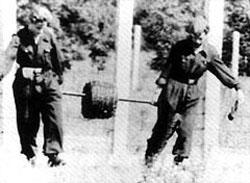 BarricadeIH 174
BarricadeIH 174
Germany, circa 1966, Color/b&w, 13 minutes. The Berlin Wall--its construction,
the reaction of the people who live near it and dramatic escapes over it by
East German civilians and soldiers--is the subject of this excellent short documentary.
Artistic montage editing techniques of authentic footage complemented by a music
score without commentary add to the dynamic pace of this film.
Battle for Britain DO 3
1944, English dialogue, 60 min. - Produced and directed by Frank Capra. Britain's
gallant stand against the encroaching Nazi horde.
Battle of Kharkov IH 277
One of the most devastating confrontations of World Ward 2 is captured in this
original German newsreel. In May 1942, when three Soviet armies collided with
Field Marshal von Bock's German force preparing its own eastward offensive at
Kharkov, Russia, the ensuing battle cost the Red Army nearly a quarter-million
men in less than two weeks.
In addition to film of the massed attacks of Soviet armor and infantry, this
classic newsreel includes spectacular footage of German aerial bombardments
and the meeting between Marshal Mannerheim and Adolf Hitler in Finland. Germany,
1942, b&w, 27 minutes, English subtitles.
Battle of Russia DO 4
English lang., b&w, ca. 83 min. - With the entire European continent under
Nazi domination, Hitler looks northward to the vast, untapped resources of Russia.
For the first time, the German War machine grinds to a frozen halt as the bitter
Russian winters and Russian resolve hand Hitler his first stunning defeat at
Stalingrad. Many historians believe The Battle of Stalingrad to be one of the
pivotal battles of the war as Hitler's forces beckoned at the gates of Moscow
and Leningrad. The Battle of Russia presents a little know, seldom seen sympathetic
side to our Russian allies of W.W.II. Nominated for an Academy Award for Best
Feature-Length Documentary, this film is a classic which drew International
praise.
The Battle of Stalingrad IH
148
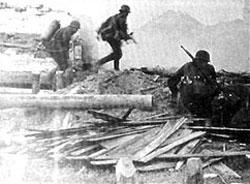 The Soviet view of the classic battle that changed the course of the war in
favor of the Allies. Rare captured German footage was used that is not found
in any other documentary produced by the Allies. USSR, 1960, b&w, 90 minutes
with English commentary.
The Soviet view of the classic battle that changed the course of the war in
favor of the Allies. Rare captured German footage was used that is not found
in any other documentary produced by the Allies. USSR, 1960, b&w, 90 minutes
with English commentary.
Berlin 1945 PA 647
60 min. b&w - A film about the final Russian conflict, the fight to take
Berlin. From Russian archival material you can now witness probably the bloodiest
battle of World War II. Over 40 Byelorussian and 1st Ukrainian army cameramen
contributed footage to this remarkable documentary.
Berlin: A Lesson in Survival
IH 282
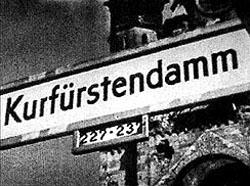 This West German promotional film highlighting the economic and cultural vitality
of West Berlin reviews the history of the city up to its unique present political
situation. Though the film honestly addresses the problems of West Berlin (uneven
age distribution, land shortage and an energy bottleneck), it stresses the city's
commitment to present and future economic growth. Germany, 1976, Color, 25 minutes,
English Commentary.
This West German promotional film highlighting the economic and cultural vitality
of West Berlin reviews the history of the city up to its unique present political
situation. Though the film honestly addresses the problems of West Berlin (uneven
age distribution, land shortage and an energy bottleneck), it stresses the city's
commitment to present and future economic growth. Germany, 1976, Color, 25 minutes,
English Commentary.
Berlin: The Doomed City DO 30
1968 English. dialogue, 65 min., b&w - On August 25, 1940, the Royal Air
Force made its first raid, beginning a five-year siege that would end only after
80,000 civilians had been killed. Even then, Goebbels was confident and ordered
his newsreel units to film the effect of British bombing, in the hopes of rallying
the German forces. This footage, suppressed until now as too harrowing to show,
brings to searing light the devastating tragedy and miracle of Berlin.
Berlin: Wie es WarCH 600
 A singular documentary portrait of the pre-war capital of the Reich. This superlative
film was finished before the outbreak of World War 2, but was not shown in movie
houses until 1950. Germany, 1942, b&w, 87 minutes, German dialogue.
A singular documentary portrait of the pre-war capital of the Reich. This superlative
film was finished before the outbreak of World War 2, but was not shown in movie
houses until 1950. Germany, 1942, b&w, 87 minutes, German dialogue.
**No Longer Available**
Berlin, The Fall of Berlin IH 149
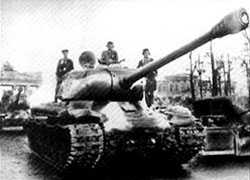 1945, b&w, 72 minutes, English commentary. Over 40 Byelorussian
and 1st Ukrainian Army cameramen contributed footage of this remarkable documentary
of the fall of Berlin, including captured German footage. Directed by Yuri Raizman.
USSR.
1945, b&w, 72 minutes, English commentary. Over 40 Byelorussian
and 1st Ukrainian Army cameramen contributed footage of this remarkable documentary
of the fall of Berlin, including captured German footage. Directed by Yuri Raizman.
USSR.
Farewell Friends-BerlinPK 7003
Documentary, English language, ca. 45 min. - Impressive documentation
of the celebrations in Berlin on the occasion of the Allies' final farewell.
Rare historic highlights recall the 1945 airlifts at Tempelhof and Gatow, the
infamous construction of the Berlin Wall in 1961, etc.
Bismarck, Sink the Bismarck BB
12
Movie, 1960, b&w, ca. 97 min. - Heroism and hard choices are the order of
the day as the English Navy desperately tries to destroy the most powerful battleship
in the world - the Bismarck. In the spring of 1941, England remains the only
undefeated nation in Europe and stands alone against Nazi Germany. But she can
survive only as long as her vital ocean supply lines remain open. The biggest
threat to shipping is Germany's floating fortress, the Bismarck, which is faster
and has more fire power than anything Britain can throw against it. In port
for the last three months, the dreaded Bismarck is now returning to the open
sea to dominate the north Atlantic. This juggernaut of destruction must be stopped,
and Churchill himself gives the order to the Royal Navy - sink the Bismarck,
at any cost.
Blitzkrieg PA 648
1986, English dialogue, 80 min., b&w - Unique visual record of the most
dramatic development of World War II - Blitzkrieg. From the German annihilation
of Poland's defenses in 1939 to the final Russian onslaught against Berlin in
1945. All original archive material. This is the Second World War as it really
happened!
Blitzkrieg, The Nazi Strike FC
702
English lang., b&w, ca 41 min. - Blitzkrieg, or "lightning war",
was the method of war adopted by Hitler and his generals. Behind the iron will
of their Fuehrer, German forces occupied and conquered Austria and Czechoslovakia
in a matter of weeks. This film documents Germany's preparations for war and
demonstrates how Hitler maneuvered politically while militarily preparing for
the conquest of Europe. The eventual attack on Poland is accurately documented
in this historical film which formed the basis of many later documentaries on
this subject.
Bomben auf Berlin: Leben zwischen Furcht und Hoffnung
CH 618
Residents of the German capital try to cope with the Battle of Berlin. They
rescue their belongings, search for new shelter, and clear away rubble, until
the city is finally captured by the Red Army. Goebbels did not want these pictures
to be shown publicly, so they are only now available for viewing after lying
in Moscow archives for almost 40 years. Germany, 1989, b&w, 90 minutes,
German commentary.
 Bonn/Bad
Godesberg
Bonn/Bad
Godesberg
Bonn/Bad Godesberg and World War 2, including the Hitler-Chamberlain meeting
in 1938, American occupation in 1945, and reconstruction and governmental deliberations
in the late '40s. Germany, 1972, b&w, 45 minutes, German commentary.
*No Longer Available*
The Bridge at Remagen BB 33
Movie, 1969, color, English lang., ca. 114 min. - March 1945. The war in Europe
is nearly over, but the fighting is more bitter than ever as U.S. and German
troops converge on The Bridge At Remagen. For the Americans, the bridge is the
last link to the heart of the Third Reich. For the retreating Germans, it is
the last hope. The tension, moral ambiguity and deadly firepower of an actual
World War II battle is bracingly captured in The Bridge At Remagen, based on
the book by Kenneth William Hechler and directed by John Guillermin. Stars George
Segal and Robert Vaughn give remarkable performances as soldiers on opposite
sides of the bridge.
The Bunker R 170
Movie, color, NR, ca. 87 min., English Lang. - Starring Anthony Hopkins, Susan
Blakely, Cliff Gorman, Richard Jordan, Michael Lonsdale. Adolf Hitler in the
last weeks in his life, struggling to maintain order as he loses control of
his country, his people and finally his own mind. It is January 1945 when Adolf
Hitler descends into a bunker beneath the Chancellery in Berlin. With the Russians
advancing on one front and the British and Americans on another, he must rely
on the few men and women loyal to the Nazi cause - his chief architect Albert
Speer, Borman, Goebbels and the mistress who became Hitler's wife in the bunker,
Eva Braun. In a powerful Emmy Award-winning performance, Anthony Hopkins portrays
Adolf Hitler over the 105 days of his decline. With The Third Reich crumbling
around him, as he rages against those of his supporters now turning against
him, in the final hours before the allied troops swarm into Berlin, Germany's
leader must make a choice between surrender... or suicide.
To view descriptions of other German war documentaries, click on the link below
 |
||||
 |
 |
 |
||
How else may I place an order?
Click on the envelope below to send e-mail
to the German Language Video Center!
Not responsible for typographical
errors.
Video run times are approximate.
Prices and availability subject to change without notice.
|
Send comments regarding contents of this
page to
|
Member VSDA since 1985.
|
| Last modified: Wednesday, July 20, 2022 6:12 PM | |
| German Language Video Center© 1997/2016 | |
| Entire
Website copyrighted 1997, 1998, 1999, 2000, 2001, 2002, 2003, 2004, 2005.
2006, 2007, 2008, 2009, 2010, 2011, 2012, 2013, 2014, 2015, 2016 No reproduction or download allowed for commercial purposes without written permission. GLVC 2016©. |
|